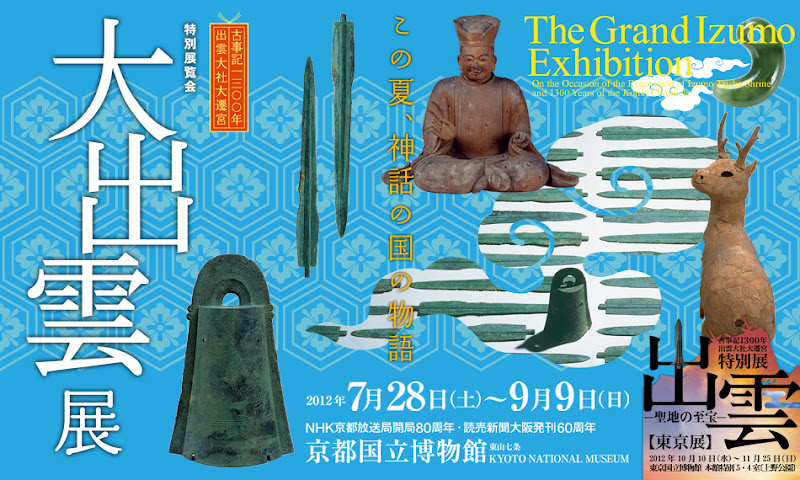"Shinkoku is the sacred name of Japan — Shinkoku, 'The Country of the Gods'; and of all Shinkoku the most holy ground is the land of Izumo," wrote Lafcadio Hearn more than 100 years ago in his book "Glimpses of Unfamiliar Japan." For Hearn, it had been an ambition to visit Shimane Prefecture's Izumo, "the land of gods" as he described it, ever since he learned about it from the "Kojiki" ("Record of Ancient Matters"), the oldest extant manuscript in Japan. Since his visit, the writer's depiction has enchanted many others and persuaded them to visit the site.

Izumo is a place of major significance in the legends of the "Kojiki." The city is well known for its Izumo Taisha, one of Japan's most revered and oldest Shinto shrines, which is dedicated to Okuninushi no Mikoto, a deity closely associated with marriage. This year marks the 1,300th anniversary of the compilation of the "Kojiki," while next year, a "grand installation" ceremony of Izumo Taisha will take place for the first time in 60 years. The grand installation marks the return of Okuninushi no Mikoto's spirit, which had been temporarily moved to another location during the shrine's renovations.
To commemorate these two events, The Kyoto National Museum presents "The Grand Izumo Exhibition," featuring archaeological finds from important historical sites in the area, as well as other exhibits. The show highlights documents and artifacts related to the "Kojiki," whose myths and legends have made it an indispensable reference in understanding the origins of Japanese culture.
In the later half of the seventh century, Emperor Tenmu (c. 631-686) commissioned the "Kojiki" to be the official history of Japan in order to help strengthen imperial rule. It was completed in 712 and the "Nihon Shoki" ("Chronicles of Japan"), another manuscript of myths and legends was compiled in 720.

The Hiikawa was known to be a raging river, which when flooded would threaten the lives of villagers, and defeating the serpent was often seen as a metaphor for controlling it. But the interpretation of this myth is varied and the image of Susanoo remains an enigma.
It is believed that one third of the myths in the "Kojiki" are about Izumo, which was once a region of power significant to the Yamato province (modern-day Nara Prefecture), the central regime of ancient Japan. The oldest version of the texts, Volume 1 (1371), a national treasure, is on display, and it serves not only as a reference to the relationship between Izumo and Yamato, but also as a manifestation of a fascinating way to record history.
In a tale depicted in the "Nihon Shoki," Okuninushi is rewarded with Izumo Shrine for giving his domain to the Heavenly Grandson, the grandson of Amaterasu. According to oral traditions, the shrine once stood at 96 meters tall, and then later at 48 meters tall. Those measurements seemed unlikely until the discovery of pillar bases on the grounds of the shrine in 2000. The massive size of the bases suggest that they could have supported a structure of 48 meters in height.
"The discovery confirms the enormity of the ancient structure as well as endorses an old construction plan of the Izumo Shrine that has been handed down through generations of the Senge family, one of the lineages of the Shinto priests of Izumo Shrine," said Katsumi Adachi, the director and curator of the Shimane Museum of Ancient Izumo.

Other great archaeological finds from Izumo include numerous bronze objects excavated from ruins at Kojindani and Kamo Iwakura — all of which have greatly informed historians' view of Izumo's role in ancient Japanese history. A spectacular display of Yayoi Period (about 300 B.C. to A.D. 300) bronze swords and bells, for example, indicate that long before the "Kojiki," Izumo had been a major place of sanctuary and formed a unique culture around the spiritual world.
By examining cultural objects related to the history of Izumo, the myths and legends of the "Kojiki" and "Nihon Shoki" can be deciphered. Those two manuscripts represented an official view of the nation's central governments and were designed to justify their rule. However another text, "Izumo no Kuni Fudoki" ("Records of Customs and Land of Izumo," completed in 733), compiled by an ancestor of an Izumo Shrine priest, tells different tales that reflect the view of local rulers.
This unprecedented exhibition is based on the results of joint investigations by the Kyoto National Museum and the Shimane Museum of Ancient Izumo, and in it Izumo emerges as a crucially significant region of ancient Japan — both politically and spiritually. Visitors will gain not only a clearer vision of Japan's history, but also a deeper understanding of the Japanese spiritual world and its land of the gods — a place often called the home of Japan's soul.
"The Grand Izumo Exhibition" at the Kyoto National Museum runs till Sept. 9; 9:30 a.m.-6 p.m. (Fri. till 8 p.m.). ¥1,300. Closed Mon. It then moves to the Tokyo National Museum from Oct. 10-Nov. 25.
Author: Sachiko Tamashige | Source: The Japan Times [August 16, 2012]